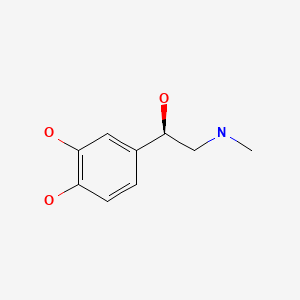Attribution Statement: LactMed is a registered trademark of the U.S. Department of Health and Human Services.
NCBI Bookshelf. A service of the National Library of Medicine, National Institutes of Health.
Drugs and Lactation Database (LactMed®) [Internet]. Bethesda (MD): National Institute of Child Health and Human Development; 2006-.
CASRN: 51-43-4

Drug Levels and Effects
Summary of Use during Lactation
No information is available on the use of epinephrine during breastfeeding. Because of its poor oral bioavailability and short half-life, any epinephrine in milk is unlikely to affect the infant. High intravenous doses of epinephrine might reduce milk production or milk letdown. Low-dose intramuscular (such as Epi-Pen), epidural, topical, inhaled or ophthalmic epinephrine are unlikely to interfere with breastfeeding. To substantially diminish the effect of the drug after using eye drops, place pressure over the tear duct by the corner of the eye for 1 minute or more, then remove the excess solution with an absorbent tissue. Epinephrine is the first line-medication of choice for treatment of anaphylaxis; it should be used in the same manner in breastfeeding and non-breastfeeding patients.
Drug Levels
Maternal Levels. Relevant published information was not found as of the revision date.
Infant Levels. Relevant published information was not found as of the revision date.
Effects in Breastfed Infants
Relevant published information was not found as of the revision date.
Effects on Lactation and Breastmilk
Relevant published information in nursing mothers was not found as of the revision date. Intravenous epinephrine infusion in nonnursing subjects and in women with hyperprolactinemia decreases serum prolactin concentrations.[1] Animal data indicate that intraarterial epinephrine can decrease serum oxytocin and inhibit milk ejection.[2,3] However, low-dose infusion of epinephrine as part of epidural analgesia does not impair breastfeeding in nursing mothers.[4,5] The prolactin level in a mother with established lactation may not affect her ability to breastfeed.
An Egyptian study compared lidocaine 2% (n = 75) to lidocaine 2% plus epinephrine 1:200,000 (n = 70) as a wound infiltration following cesarean section. Patients who received epinephrine in combination with lidocaine began breastfeeding at 89 minutes following surgery compared to 132 minutes for those receiving lidocaine alone. The difference was statistically significant.[6]
References
- 1.
- Nicoletti I, Filipponi P, Sfrappini M, et al. Catecholamines and pituitary function. I. Effects of catecholamine synthesis inhibition and subsequent catecholamine infusion on gonadotropin and prolactin serum levels in normal cycling women and in women with hyperprolactinemic amenorrhea. Horm Res. 1984;19:158–70. [PubMed: 6425187]
- 2.
- Gorewit RC, Aromando MC. Mechanisms involved in the adrenalin-induced blockade of milk ejection in dairy cattle. Proc Soc Exp Biol Med. 1985;180:340–7. [PubMed: 4048172]
- 3.
- Song SL, Crowley WR, Grosvenor CE. Evidence for involvement of an adrenal catecholamine in the beta-adrenergic inhibition of oxytocin release in lactating rats. Brain Res. 1988;457:303–9. [PubMed: 2851365]
- 4.
- Chang ZM, Heaman MI. Epidural analgesia during labor and delivery: Effects on the initiation and continuation of effective breastfeeding. J Hum Lact. 2005;21:305–14. [PubMed: 16113019]
- 5.
- Radzyminski S. The effect of ultra low dose epidural analgesia on newborn breastfeeding behaviors. J Obstet Gynecol Neonatal Nurs. 2003;32:322–31. [PubMed: 12774874]
- 6.
- Tharwat AA, Yehia AH, Wahba KA, et al. Efficacy and safety of post-cesarean section incisional infiltration with lidocaine and epinephrine versus lidocaine alone in reducing postoperative pain: A randomized controlled double-blinded clinical trial. J Turk Ger Gynecol Assoc. 2016;17:1–5. [PMC free article: PMC4794285] [PubMed: 27026771]
Substance Identification
Substance Name
Epinephrine
CAS Registry Number
51-43-4
Drug Class
Breast Feeding
Adrenergic Agonists
Adrenergic alpha-Agonists
Adrenergic beta-Agonists
Antiglaucoma Agents
Bronchodilator Agents
Catecholamines
Mydriatics
Sympathomimetics
Vasoconstrictor Agents
Disclaimer: Information presented in this database is not meant as a substitute for professional judgment. You should consult your healthcare provider for breastfeeding advice related to your particular situation. The U.S. government does not warrant or assume any liability or responsibility for the accuracy or completeness of the information on this Site.
- User and Medical Advice Disclaimer
- Drugs and Lactation Database (LactMed) - Record Format
- LactMed - Database Creation and Peer Review Process
- Fact Sheet. Drugs and Lactation Database (LactMed)
- Drugs and Lactation Database (LactMed) - Glossary
- LactMed Selected References
- Drugs and Lactation Database (LactMed) - About Dietary Supplements
- Breastfeeding Links
- PMCPubMed Central citations
- PubChem SubstanceRelated PubChem Substances
- PubMedLinks to PubMed
- Review Phenylephrine.[Drugs and Lactation Database (...]Review Phenylephrine.. Drugs and Lactation Database (LactMed®). 2006
- Review Norepinephrine.[Drugs and Lactation Database (...]Review Norepinephrine.. Drugs and Lactation Database (LactMed®). 2006
- NTP Toxicology and Carcinogenesis Studies of l-Epinephrine Hydrochloride (CAS No. 55-31-2) in F344/N Rats and B6C3F1 Mice (Inhalation Studies).[Natl Toxicol Program Tech Rep ...]NTP Toxicology and Carcinogenesis Studies of l-Epinephrine Hydrochloride (CAS No. 55-31-2) in F344/N Rats and B6C3F1 Mice (Inhalation Studies).National Toxicology Program. Natl Toxicol Program Tech Rep Ser. 1990 Mar; 380:1-205.
- Review Fluorometholone.[Drugs and Lactation Database (...]Review Fluorometholone.. Drugs and Lactation Database (LactMed®). 2006
- Review Cyclopentolate.[Drugs and Lactation Database (...]Review Cyclopentolate.. Drugs and Lactation Database (LactMed®). 2006
- Epinephrine - Drugs and Lactation Database (LactMed®)Epinephrine - Drugs and Lactation Database (LactMed®)
Your browsing activity is empty.
Activity recording is turned off.
See more...
